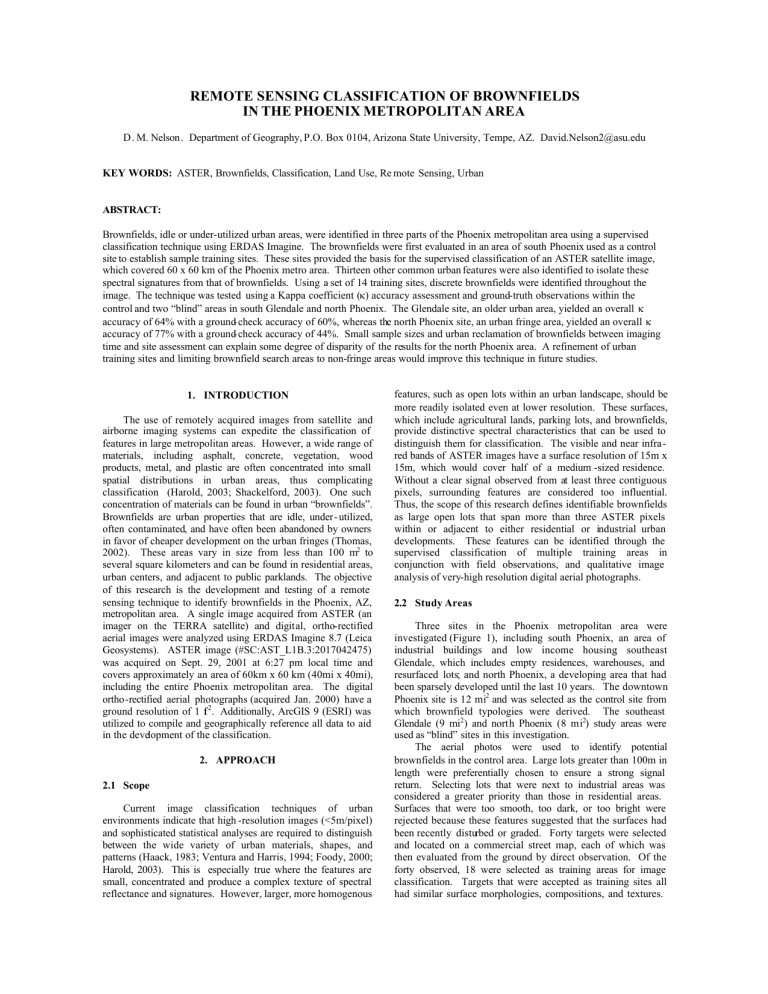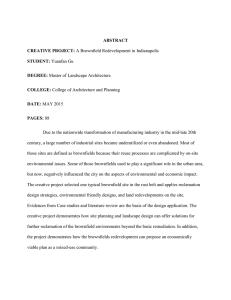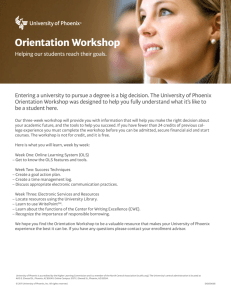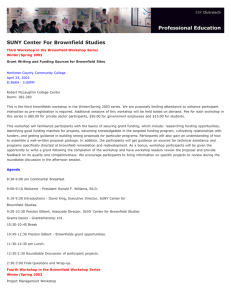REMOTE SENSING CLASSIFICATION OF BROWNFIELDS IN THE PHOENIX METROPOLITAN AREA

REMOTE SENSING CLASSIFICATION OF BROWNFIELDS
IN THE PHOENIX METROPOLITAN AREA
D . M. Nelson. Department of Geography, P.O. Box 0104, Arizona State University, Tempe, AZ. David.Nelson2@asu.edu
KEY WORDS: ASTER, Brownfields, Classification, Land Use, Re mote Sensing, Urban
ABSTRACT:
Brownfields, idle or under-utilized urban areas, were identified in three parts of the Phoenix metropolitan area using a supervised classification technique using ERDAS Imagine. The brownfields were first evaluated in an area of south Phoenix used as a control site to establish sample training sites. These sites provided the basis for the supervised classification of an ASTER satellite image, which covered 60 x 60 km of the Phoenix metro area. Thirteen other common urban features were also identified to isolate these spectral signatures from that of brownfields. Using a set of 14 training sites, discrete brownfields were identified throughout the image. The technique was tested using a Kappa coefficient (
κ
) accuracy assessment and ground-truth observations within the control and two “blind” areas in south Glendale and north Phoenix. The Glendale site, an older urban area, yielded an overall
κ accuracy of 64% with a ground- check accuracy of 60%, whereas the north Phoenix site, an urban fringe area, yielded an overall
κ accuracy of 77% with a ground- check accuracy of 44%. Small sample sizes and urban reclamation of brownfields between imaging time and site assessment can explain some degree of disparity of the results for the north Phoenix area. A refinement of urban training sites and limiting brownfield search areas to non-fringe areas would improve this technique in future studies.
1. INTRODUCTION features, such as open lots within an urban landscape, should be
The use of remotely acquired images from satellite and airborne imaging systems can expedite the classification of features in large metropolitan areas. However, a wide range of materials, including asphalt, concrete, vegetation, wood products, metal, and plastic are often concentrated into small spatial distributions in urban areas, thus complicating classification (Harold, 2003; Shackelford, 2003). One such concentration of materials can be found in urban “brownfields”.
Brownfields are urban properties that are idle, under- utilized, often contaminated, and have often been abandoned by owners in favor of cheaper development on the urban fringes (Thomas,
2002). These areas vary in size from less than 100 m 2 to several square kilometers and can be found in residential areas, urban centers, and adjacent to public parklands. The objective more readily isolated even at lower resolution. These surfaces, which include agricultural lands, parking lots, and brownfields, provide distinctive spectral characteristics that can be used to distinguish them for classification. The visible and near infrared bands of ASTER images have a surface resolution of 15m x
15m, which would cover half of a medium -sized residence.
Without a clear signal observed from at least three contiguous pixels, surrounding features are considered too influential.
Thus, the scope of this research defines identifiable brownfields as large open lots that span more than three ASTER pixels within or adjacent to either residential or industrial urban developments. These features can be identified through the supervised classification of multiple training areas in conjunction with field observations, and qualitative image analysis of very-high resolution digital aerial photographs. of this research is the development and testing of a remote sensing technique to identify brownfields in the Phoenix, AZ, metropolitan area. A single image acquired from ASTER (an imager on the TERRA satellite) and digital, ortho-rectified aerial images were analyzed using ERDAS Imagine 8.7 (Leica
Geosystems). ASTER image (#SC:AST_L1B.3:2017042475) was acquired on Sept. 29, 2001 at 6:27 pm local time and covers approximately an area of 60km x 60 km (40mi x 40mi), including the entire Phoenix metropolitan area. The digital ortho-rectified aerial photographs (acquired Jan. 2000) have a ground resolution of 1 ft
2
. Additionally, ArcGIS 9 (ESRI) was utilized to compile and geographically reference all data to aid in the development of the classification.
2. APPROACH
2.1 Scope
Current image classification techniques of urban environments indicate that high -resolution images (<5m/pixel) and sophisticated statistical analyses are required to distinguish between the wide variety of urban materials, shapes, and patterns (Haack, 1983; Ventura and Harris, 1994; Foody, 2000;
Harold, 2003). This is especially true where the features are small, concentrated and produce a complex texture of spectral reflectance and signatures. However, larger, more homogenous
2.2 Study Areas
Three sites in the Phoenix metropolitan area were investigated (Figure 1), including south Phoenix, an area of industrial buildings and low income housing; southeast
Glendale, which includes empty residences, warehouses, and resurfaced lots; and north Phoenix, a developing area that had been sparsely developed until the last 10 years. The downtown
Phoenix site is 12 mi
2
and was selected as the control site from which brownfield typologies were derived. The southeast
Glendale (9 mi
2
) and north Phoenix (8 mi
2
) study areas were used as “blind” sites in this investigation.
The aerial photos were used to identify potential brownfields in the control area. Large lots greater than 100m in length were preferentially chosen to ensure a strong signal return. Selecting lots that were next to industrial areas was considered a greater priority than those in residential areas.
Surfaces that were too smooth, too dark, or too bright were rejected because these features suggested that the surfaces had been recently disturbed or graded. Forty targets were selected and located on a commercial street map, each of which was then evaluated from the ground by direct observation. Of the forty observed, 18 were selected as training areas for image classification. Targets that were accepted as training sites all had similar surface morphologies, compositions, and textures.
The areas were relatively flat, with indications that they had been smoothed or plowed in previous years, where the scrub and cobbles had been removed, although some currently had hummocks of dirt or gravel. The surfaces were composed primarily of dirt, gravel (0.5”-1.5” diameter), and cobbles (2”-
5” diameter), which were to some degree overgrown by desert scrub. Most lots were devoid of trees, but many had Mesquite or Palo Verde trees growing along the perimeter of both residential and industrial properties.
Figure 1.
Study areas in the Phoenix metropolitan area.
3. CLASSIFICATION
3.1 Unsupervised Classification
The first step in identifying brownfields in the ASTER image was by performing an unsupervised classification to determine potential classes through a non-interactive, automated process. This was performed using the ERDAS
Imagine algorithm ISODATA, which uses a minimum spectral distance statistical formula to cluster pixels of like spectral values (Leica Geosystems, 2003). This is an iterative process, where an initial arbitrary cluster mean (average class pixel value) is established and the pixels are grouped into a userdefine d number of classes (10 in this case). The process is reevaluated, based on the previous run, and re-evaluated again until the process has reached a threshold where 95% of the analyzed pixels remain in the same class through a successive iteration. The portion of the classified image that corresponded to the control area (south Phoenix site) was compared to the aerial photographs and the brownfield training sites established by ground observations. The unsupervised classification isolated different agricultural classes, open lots, asphalt roads, freeways and parking lots, as well as residential and industrial structures. Unfortunately, lakes and shadows (from buildings and mountains) were also grouped with asphalt, and the open lots category initially included the Salt River, brownfields, graded fields, and all other relatively barren surfaces.
3.2 Supervised Classification
In the supervised classification of the ASTER image, the brownfield training sites were delineated on the ASTER image.
In most cases, the training area consisted of well over 50 pixels.
Two or three training samples were selected for other classification targets, which were based on unsupervised classification results. The targets, identified from the aerial photographs, consisted of large obvious features, including four
Agriculture types, Lakes, Residential, industrial Buildings,
Concrete, Asphalt and parking lots, the Salt River wash, Bare
Soil, Coarse Materials, Shaded Areas, and Brownfields.
Agriculture was identified by varying degrees of brightness in near-infrared, which is strongly reflected by vegetation. A
Residential class was created by sub- sampling several highly complex signatures that included high values in overlapping green (“urban”), near infra-red (vegetation), and dark values
(pavement). Asphalt, including roads, parking lots, and some freeways, were grouped into a single class. The Salt River, a dry river bed that passes through the control area and consists of very coarse materials (cobbles 4”-10”), was defined as a separate class. Bare soil consisted of smooth bright areas that had little to no texture and no vegetation, and Coarse Materials, sampled from the banks of the Salt River, are unvegetated surfaces with an uneven mix of large gravel and cobbles with a small proportion of exposed soil. These last two classes are considered recently disturbed because of the lack of vegetation and are therefore considered distinct from Brownfields.
A contingency matrix was created to test the viability of the selected classes. This algorithm reviews all of the selected signatures to determine the degree of overlap found between each of the signatures, and is based on a Maximum Likelihood
“decision rule”. This decision rule evaluates the variance
(range of DN values) and the covariance (correlation or overlap between signature classes) of each of the established classes in order to derive the probability of each pixel falling into a particular class. The evaluated probabilities are equal (nonweighted) for all classes. When the probability of each pixel’s potential has been calculated, the pixel is then assigned to the class with the highest probability (Lillesand et al., 2004).
Successive classifications and evaluations enabled the isolation of 14 distinct classes. The matrix showed that most of the new classes were spectrally more distinct. Brownfields, however, still appeared to overlap with Salt River and Bare Soil. At first glance, the classification did not seem to be promising as a distinct spectral signature. However, an ERDAS “threshold” tool, which performs a “goodness of fit” test, indicated a much better distribution of the Brownfield pixel values than for Bare
Soil or Salt River. The threshold test calculates the potential percentage of pixels misclassified at a user-defined confidence level. In this study, a goodness of fit signature for the
Brownfields was more important to ascertain than that of the
Bare Soils or Salt River and, from this evaluation, it was assumed that the new classification would result in an underestimation of Brownfields and an overestimation of Bare
Soils or Coarse Materials classed pixels (Leica Geosystems,
2003).
3.3 Results of the Supervised Classification
The results of the second and final supervised classification indicated a widely distributed Residential class, more Agriculture sites, and more constrained Brownfield and
Bare Soil areas. Aerial photos were used to corroborate the classified image with classes in the control study area.
Qualitatively, the classed features appeared to match well with the corresponding features in the photographic images. This was especially the case for the agriculture classes, Asphalt, and
Residential. Unfortunately, while the original training sites contained mostly Brownfield signatures, some mixing from
Bare Soils, Coarse Materials, and (to a small extent) Salt River was present in each. One t raining site, which had a component of large cobbles and old asphalt, was classified as Salt River and Coarse Materials. Such a result for the targets was not completely unexpected. Surfaces at each of the sites varied with respect to distribution of gravel/cobble size and amount, as well as vegetation coverage. In addition, the spectral overlap
from the other classes indicated that a reduction of the
Brownfield signature was likely.
3.4 Testing the Identification Technique
The accuracy testing of the technique described in this study was performed using two methods. The first was a statistics approach used in ERDAS Imagine that evaluates the pixels of the image that was classified by the user (training sites) against a randomly classified image by the computer and how well the test was performed. The second was a ground truth check of a random selection of sites in the two blind study areas, southeast Glendale and north Phoenix.
The standardized method of measuring the classification of an image in ERDAS Imagine is through the calculation of the kappa coefficient of agreement. Introduced by Congalton et al. (1983) to assess early Landsat image classifications, the kappa coefficient uses multivariate analysis on the discrete values of the classified pixels by comparing the two error matricies generated by the computer and the user’s inputs. This value is calculated by:
(1) where n is the pixel class value, q is the number of classes, and k is the matrix cell location in a “k x k” matrix (where k, … , k+ is the actual class axis and k, … , +k is the predicted class axis). The result is a value that indicates the percentage of the misclassification error that was avoided compared to that which is generated from a completely random classification
(Congalton, 1991).
The kappa coefficient for the brownfields for the two
Phoenix sites were relatively high (south Phoenix: 79.6%, north
Phoenix: 76.7%), although the Glendale score was somewhat lower (64%). However, the accuracies of the user’s classes were all less than the suggested target of 85% accuracy (Foody,
2002), with overall accuracies below 72% (south Phoenix:
66.3%, north Phoenix: 60.3%, Glendale: 71.1%).
A field check of the two “blind” sites was performed as a second method of checking the results of the classification technique described in this investigation. Thirty-two random brownfield classed sites were identified in the southeast
Glendale area and 30 in the north Phoenix area for ground observation. Each target was evaluated whether it satisfied the definition of brownfield used in this study and ranked with a value of “yes”, “no”, or “OK?”. “Yes” indicated that the site covered the approximate surface extent on the map and met the brownfield definition. “No” indicated that the feature was misclassified. Some targets had brownfield characteristics, but did not fit the strict definition (e.g., the site was an undevelope d residential yard), and was given a neutral value “OK?”. Other sites that had been reclaimed since the time of imaging (2001), typically by a new residential development, were not considered valid sites.
Of the 32 point ground points in the older, urban Glendale site, 7 had been reclaimed since the 2001 imaging time.
Ground truth evaluation yielded values of 60% accuracy, 24% ambiguous, and 16% misclassified. The accuracy is within a few percentage points given by the kappa coefficient. The north Phoenix urban fringe area showed marked development in the last 3 years and only 18 of the 30 target sites were left unchanged. The results of ground observation for this area are:
44.4% accurate, 38.9% ambiguous, and 16.6% misclassified.
The difference betwe en the ground assessment and the kappa value is much greater for this area, but because of the small number of observations, results are probably not well represented.
4. Conclusions
The identification of brownfields in this study met with mixed result s. T he supervised classification of a single ASTER image produced a classified map which revealed abandoned lots down to the resolution of the image (15m). However, the assessment of the technique indicated that the accuracy of the classification was only moderate: 64-80%. Several problems encountered throughout the study made the identification process challenging; these issues would need to be addressed in a future study. Results from the north Phoenix site were particularly unsatisfactory. This was because the level of rapid development of the area was not taken into account. An additional study area, perhaps another older city center, should have been chosen. Larger study areas might also have been helpful and a greater number of field check points would have produced more statistically reliable results.
Distinguishing between Brownfields, Bare Soil, and
Coarse Materials classes was a recurring problem throughout the image classification and testing part of this study. Because the objective of the project was only the identification of brownfields, less care was taken to develop specific criteria to identify the other two classes. Future work should include sampling an equal number of training sites for the classes similar to brownfields in order to more accurately delineate these spectral signatures. Similarly, because vegetation coverage did play role, albeit a modest one, in the resolution of
Brownfields, Bare Soil, and Coarse Materials, a detailed field analysis of the type and amount of veget ation coverage for each class type could be performed. In non- arid climates, a greater consideration for vegetation coverage would need to be given.
Improved techniques and results developed from the research performed in Phoenix, AZ, could eventually be applied to other cities, making the identification and evaluation of brownfields through remote senising analyses more time- and cost-effective. This in turn would enable developers to more easily evaluate areas that could be reclaimed for public or commercial use.
References.
Congalton, R.G., 1991. A review of assessing the accuracy of classifications of remotely sensed data, Rem. Sens. of Env.
37:35-46.
Congalton, R.G., et al., 1983. Assessing Landsat classification accuracy using discrete multivariate analysis statistical techniques,
Photogramm. Eng. Rem. Sens.
, 49(12):1671-1678.
Foody, G.M. 2000. Estimation of sub-pixel land cover composition in the presence of untrained classes. Comp. & Geosci.
, 26:469 -478.
Foody, G.M., 2002. Status of land cover classification accuracy assessment. Rem. Sens. of Env , 80:185 -201
Haack, B.N., 1983. An analysis of Thematic Mapper simulator data for urban environments. Rem. Sens. of Env , 13:265-275.
Harold, M., 2003. Spectral resolution requirements for mapping urban areas. IEEE Trans. Geosci. Rem. Sens.
, 41(9):1907-1919.
Leica Geosystems, 2003. ERDAS Imagine Tour Guides , GIS &
Mapping, LLC, Atlanta, GA, pp. 638.
Lillesand, T.M., et al., 2004. Remote Sensing And Image
Interpretation, 5 th
ed . Wiley & Sons, Inc., New Jersey, pp. 763.
Shackelford, A.K., 2003. A Hierarchical fuzzy classification approach for high -resolution multi-spectral data over urban areas. IEEE Trans.
Geosci . Rem. Sens , 41(9):1920-1932
Thomas, M.R., 2002. A GIS-based decision support system for brownfield redevelopment. Landscape and Urban Planning , 58:7-23.
Ventura, S.J., and P. Harris, 1994. A comparison of classification techniques and data sources for urban land use mapping. Geocarto
International , 3:5-14.

![Car Wash - Teachers [] - Carnegie Mellon University](http://s3.studylib.net/store/data/007759052_2-dc7f9f6e7ee8d5936ad1af830ebd5069-300x300.png)




